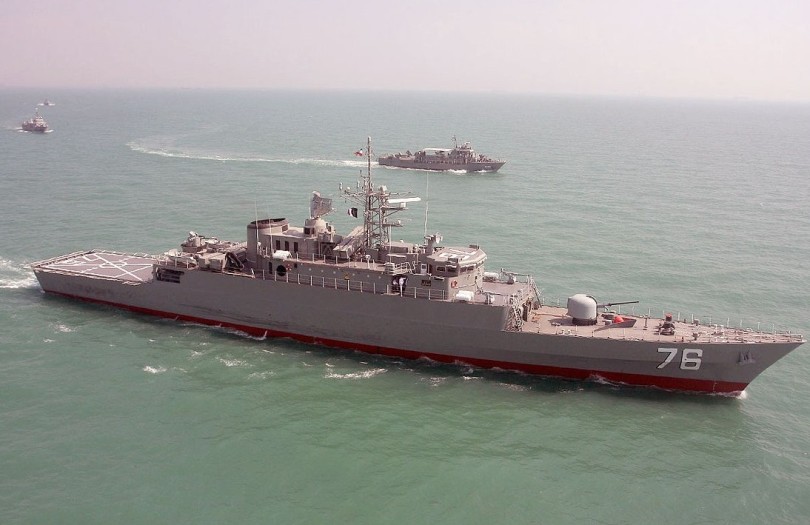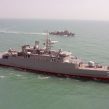
New Wave of Militarization in the Caspian
Publication: Eurasia Daily Monitor Volume: 10 Issue: 61
By:

On March 17, the Iranian navy launched a new Jamaran-2 destroyer in the Caspian Sea. The Iranian establishment, including President Mahmoud Ahmadinejad, Iranian Defense Minister Ahmad Vahidi and Chief of Staff of the Armed Forces Hassan Firuzabadi, attended the ceremony. This destroyer was developed and constructed domestically by Iranian experts and specialists. Earlier, a Jamaran-1 destroyer was launched in the Persian Gulf. The 1,420-ton destroyer, which is part of the 16th fleet of Iranian warships, is equipped with modern radars and electronic warfare capabilities. The Jamaran-2 has a top speed of up to 30 knots and a helipad. The destroyer features highly advanced anti-aircraft, anti-surface and anti-subsurface systems. The vessel has also been equipped with torpedoes and naval cannons (Trend, March 17). Conspicuously, the Iranian destroyer was launched exactly on the eve of the start of bilateral talks between Azerbaijan and Russia on the Caspian Sea delimitation issues. On March 18, Azerbaijani Deputy Foreign Minister Khalaf Khalafov met with Igor Bratchikov, the special envoy of the Russian foreign ministry. The sides discussed issues of mutual cooperation in the Caspian, including the drafting of a convention on the legal status of the Caspian Sea and many others (Zerkalo, March 18).
Azerbaijani officials tend not to comment on the militarization of the Caspian and try to avoid public discussions on this topic. Ali Hasanov, the head of the Azerbaijani presidential administration’s Social and Political Department said in Istanbul last year that the Caspian Sea area is not a militarized region despite Russian, Azerbaijani, Turkmenistani and Iranian border structures located there (Trend, December 6, 2012). Nevertheless, the Caspian Sea is a place of intense global geostrategic importance, he remarked (https://www.caspianforum.org/PressNews/Detail/5). Despite the neutral rhetoric, Azerbaijan’s establishment is, in fact, concerned about the ongoing militarization of the Caspian and especially with threats coming from Iran.
In mid-April 2012, Azerbaijan’s State Border Service (SBS) successfully completed week-long tactical exercises in the Azerbaijani sector of the Caspian Sea that involved around 1,200 servicemen, 21 ships, 20 speedboats as well as eight helicopters (Defence.az, April 18, 2012). The nature of Azerbaijan’s military exercises suggested the actions were directed against an enemy possessing helicopter, ship and even submarine capabilities. Moreover, in 2011–2012, Azerbaijan purchased from Israel arms worth $1.5 billion. Among other military equipment and weapons systems, Israel supplied Baku with Israeli-made Gabriel-5 anti-ship missiles. At that time, experts stressed that the exercises and arms purchases reflected Azerbaijan’s concerns over Iran’s militarization (see EDM, May 17, 2012).
The new wave of naval strengthening launched a few years ago, has forced other Caspian littoral states to build up their fleets in response. On January 30 of this year, the Russian Ministry of Defense ordered the construction of three new Buyan-class corvettes to be used in the Caspian. The first ship will be launched this year, while two others will be completed by 2014. Retired Rear Admiral Vladimir Zakharov stressed that the new ships significantly increase the influence of Russia’s fleet over the Caspian region. “We should not forget unstable Iran. Three ships are a minimum that we need to use in the region. At a maximum the Caspian fleet would need seven such ships,” he concluded (Aze.az, January 30). In July of 2012, Russia launched the new military ship “Dagestan,” equipped with SS-N-27 “Sizzler” missiles (RIA Novosti, March 18). This is the first military ship in Russia equipped with this type of missile. With the launching of the Dagestan, the Russian Caspian fleet has increased its number of Gepard-class frigates to two (the first one is the “Tatarstan”).
At the same time, earlier in April 2012, another Caspian littoral state, Kazakhstan, launched a new domestically produced rocket-artillery ship. The vessel, a surface combatant, features a new rocket-artillery system as well as modern navigation. In 2013, Kazakhstan will launch two more of these rocket-artillery ships; and in 2016, Astana plans to open a marine training station (Nur.kz, April 25, 2012).
It is unlikely that any of the countries of the Caspian Basin will dare to offensively use their navies against their neighbors. Any military conflict in the Caspian could easily escalate into a full-scale war between the countries, and even spill over into the wider region. Nevertheless, each of the littoral states has its own reason to build up its naval presence in the Caspian: whether it is to intimidate its neighbors (in case of Iran); prevent an attack from other states in the region (Azerbaijan); to show military might (Russia); or to simply not lag behind their neighbors (Turkmenistan and Kazakhstan). When combined, however, these policies may lead to an arms race and a dangerously heavy militarization of the Caspian Sea, which may, in fact, make it more difficult to prevent future military conflicts among the states in this tense region.




